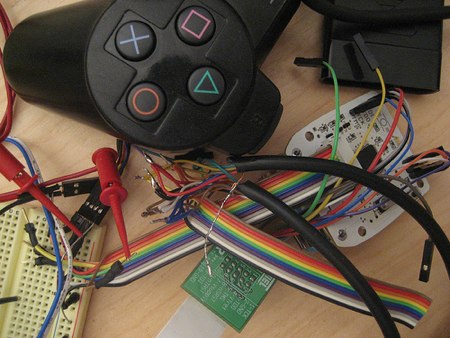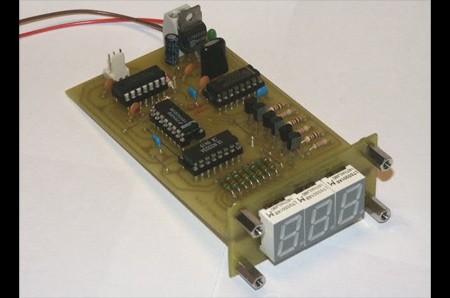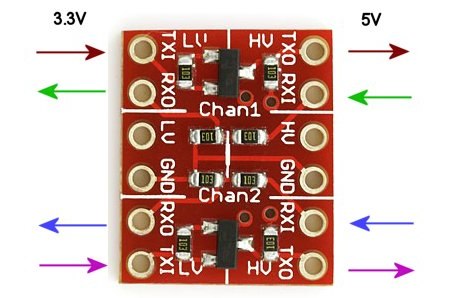
The people at Near Future Laboratory are trying to spoof the behavior of a Playstation 2 controller using just a microcontroller. They wrote some initial code using the controller info found here, but decided the best way to figure out what was going on, was to probe the interface. They’re using a Logicport, which features 34 channels plus two clock channels. They only need six channels because the PS2 implements an SPI protocol plus an ACK line. The post is just a preliminary investigation, but will give you a little insight into how the Logicport works and why you might find it useful.
Day: June 19, 2008
Ice On Mars

It’s official: the Phoenix Lander has discovered ice on Mars. A few days ago, the lander exposed some bright white chunks of material while retrieving a soil sample. These spots have since disappeared over the following days, suggesting they’ve melted. An additional trench found a hard layer at the same depth as the original ice.
The spacecraft team has been dealing with some data storage issues as well and will be pushing a software patch soon.
EM Brace For Sensing Magnetic Fields
We’ve discussed the notion of using machines to add or improve sensory input to the body before, and we’ve found another project with the same idea. [Nick Hasty] has developed an object he calls the EM Brace, which allows the user to sense electromagnetic fields with a wave of the hand.
The device works by connecting two antennas to an enclosure that contains a speaker. The enclosure is intended to be worn on the back with a harness securing it in place and wrapping the arms around the wearer’s body. The antennas are incorporated into a pair of gloves. When the antennas pick up electromagnetic radiation, the speaker emits a low frequency sound waves. They vibrate the enclosure and the arms, which in turn vibrate the body, signaling to the wearer that he or she is in an electromagnetic field, also referred to as hertzian space. A good deal of detail about the project can be found on his blog, or if you prefer, download his thesis paper in(PDF).
[via Make]
Eavesdropping Encrypted Compressed Voice

A team from Johns Hopkins University has discovered a way to eavesdrop on encrypted voice streams. Voice data like the kind used by Skype for its VoIP service sends encrypted packets of varying sizes for different sounds. The team learned that by simply measureing the size of the packets, they could determine what was being said with a high rate of accuracy. VoIP providers often use a variable bit rate to use bandwidth more efficiently, but it is this compression that makes audio streams vulnerable to eavesdropping.
The team’s software is still in its early stages of development, yet incapable of parsing entire conversations. It is capable, though, of finding pre-determined keywords and inferring common phrases bases on the words it detects. It also has a higher rate of accuracy in identifying long complicated words than short ones. The team’s goal was not to eavesdrop, but to expose the vulnerability; team member [Charles Wright] notes, “we hope we have caught this threat before it becomes too serious.”
[via Schneier on Security]
[photo: altemark]
3-digit Frequency Meter

Flow sensors are useful tools for collecting data on the rate of liquid usage, but they need a device to display the data they collect. This three digit frequency meter was designed by [Turbokeu] to do just that, converting a Swissflow SF800 flow sensor’s square wave signal (similar to fan RPM signals) into an numerical expression of liters per minute on a 3 digit LCD. Fan RPM is
[Turbokeu] provides detailed schematics of different configurations for the frequency meter as well as schematics of the layouts of the two PCBs that are used. Even if you don’t have an immediate use for a frequency meter, his clean and readable schematics are worth a look in their own right. The display is installed on front of a tower case along side a CPU speed display.
[via YourITronics]
SparkFun’s Logic Level Converter

SparkFun has always been good about designing and stocking useful breakout boards. This recently added Logic Level Converter is no exception. It’s uses two BSS138 MOSFETs to shift 5V logic levels to 3.3V. The board handles two separate serial pairs. Just hook up the RX and TX on either side. Provide power at both voltages and the board will happily do the conversion. It’s $2, smaller than the size of a quarter, and perfect for plugging into a breadboard.
OpenSUSE 11.0 Reviewed

Download squad has posted a thorough review of OpenSUSE 11.0. Previous versions of the Linux distro were plagued by thorny and confusing installations, but OpenSUSE 11.0 installs much more easily and cleanly. After a few standard configuration screens, the user has several options for admin accounts, disk partitions, dual-boot setups, and more. The installation of the OS files takes about 20 minutes from there, followed by a quick reboot and first boot, making for a highly customizable yet speedy install from start to finish.
The other major problem with previous versions was the inconsistent speed of their package handling system. In 11.0, though, a new command line app called Zypper makes installing updates, patches, and other packages much faster.
The final verdict is that OpenSUSE 11.0 has become a viable alternative to Ubuntu; the overall quality of the open source distro was never in question, but now that speed has gone from being its biggest deficiency to being one of its biggest strengths, we expect to see a lot more chameleons in the wild.











